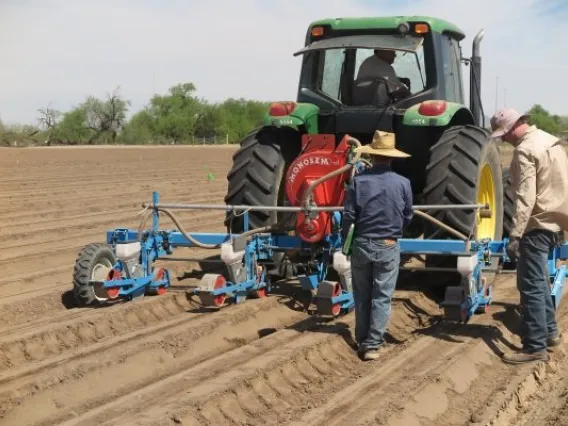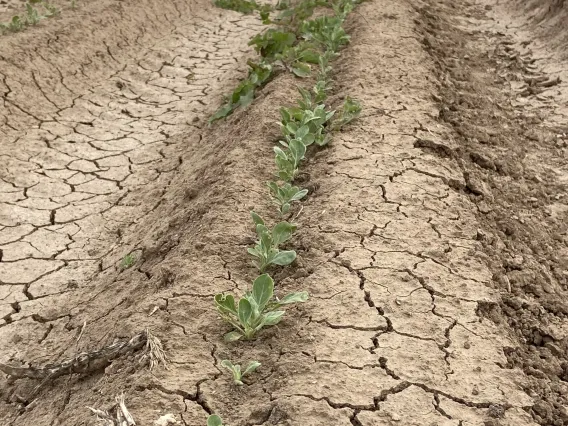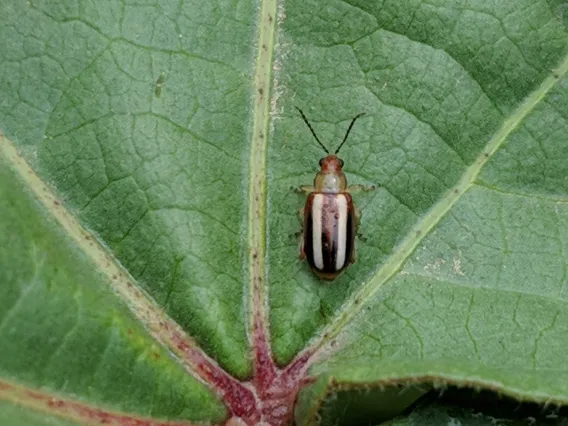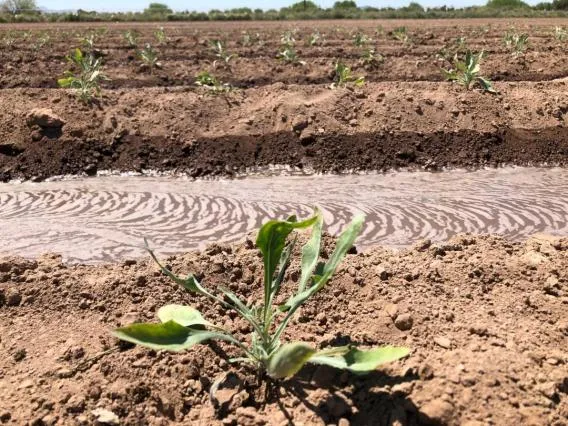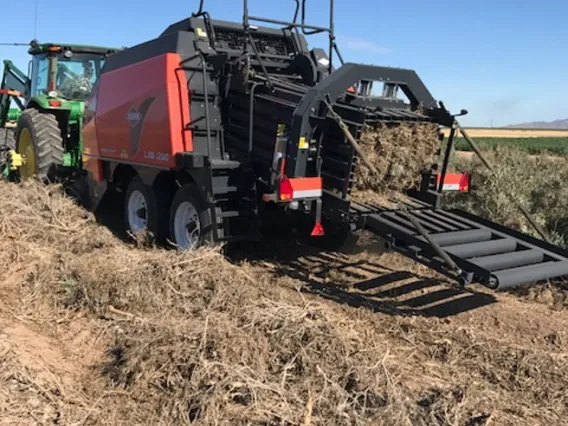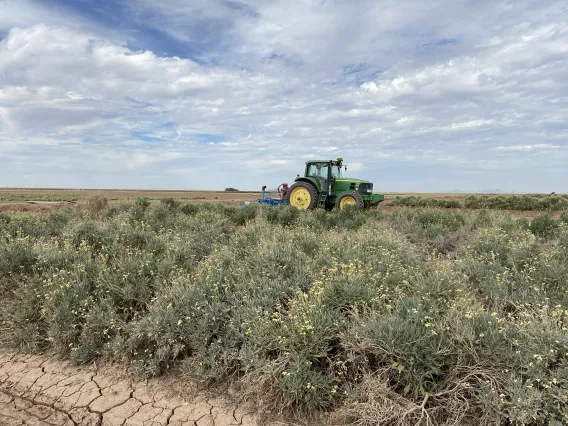Guayule Basics
Guayule (Parthenium argentatum) is a plant that is native to the deserts of southern United States and Northern Mexico. Because guayule is a desert plant, it is very drought tolerant and can survive under harsh conditions. Guayule can produce natural rubber which is a valuable commodity for the manufacture of tires, gloves, and other products where natural rubber is demanded. Guayule rubber is different from the latex rubber imported from the tropics; in that it does not contain latex allergen that may present health-related challenges for sensitive individuals.
Currently, guayule has been domesticated and is currently grown by some farmers in Arizona. The Sustainable Bioeconomy for Arid Regions Center is funding several projects to develop guayule as an economic crop for farmers in the southwestern region. On-going research activities include cultivar selection for cold tolerance, irrigation management, and insect and weed control. Bridgestone Americas Inc. has been a strong partner of the SBAR Center for the advancement of guayule research in the Southwest.
-
Document
-
Document
-
Document
-
Document
Guayule Cultivar Selection
Plant breeders have increased rubber yield per acre by increasing biomass production. However, rubber content (rubber concentration in the plant) has remained about the same for some time. This is because biomass yield has a much higher heritability and is easier to change in the short-term. Now that there are more plant breeders involved in guayule improvement, selection for rubber content is becoming a focus as well as resin production. In addition to larger plants, breeders have increased seed production and quality, resulting in higher seed germination rates and increased plant uniformity.
Recent testing of guayule lines by SBAR researchers has reinforced AZ-2 as an excellent choice for field production. It performed well across multiple locations under varying production conditions, and can be established by direct-seeding. Under large-scale commercial production, guayule will be grown in many different soil types, with different water quality levels, and under the influence of different microclimates. This is why it is so important for a specific variety to “travel well.”
Bridgestone Americas is working to breed new varieties to increase rubber content and yield, and to maximize co-products that are derived from the plants. As these new varieties are developed, Bridgestone Americas will work with growers to establish plantings in areas where they will perform best.
Land Preparation and Planting Guayule
Seeds from the guayule plant are approximately 1.6-1.8mm in diameter, which requires proper land preparation and precise planting to establish a quality stand. The anticipated life of a stand is 6 years with 3 regenerative harvest every two years; thus, it is of the utmost importance to ensure that every measure is taken to produce a good stand that will produce multiple quality harvests.
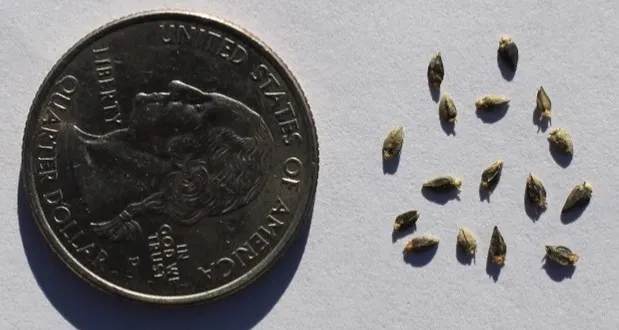
Guayule’s small seeds require specialized planting equipment to ensure proper planting rate and depth.
Soil preparation should begin with subsoiling to ensure that root development is not restricted by a hard pan. Guayule roots extend deep into the soil, scavenging essential water and nutrients. Eliminating any compaction zones will ensure maximum rooting depth. In Central Arizona, growers typically use a parabolic ripper for subsoiling followed by double disking to break compacted soil clods. Next, fields should be leveled and/or landplaned to ensure proper slope and level field for irrigation before bed creation. The first step in building a bed is typically to run a lister on a GPS-guided tractor to ensure straight, uniform beds. In cloddy soil, beds must be cultivated and shaped for a smooth, uniform planting surface. In soils without clodes, it may be possible to plant directly into well-formed beds.
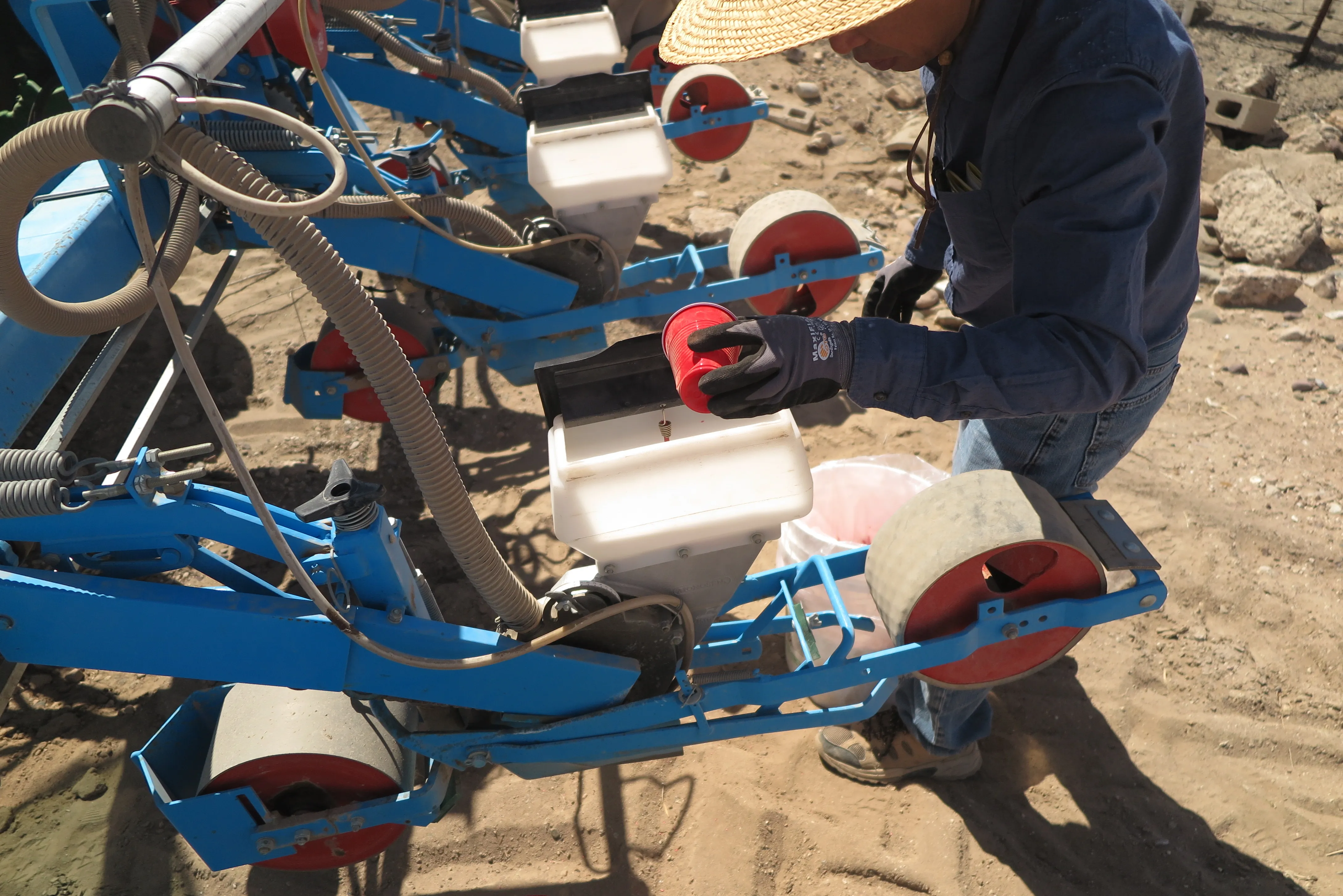
Loading guayule seeds into the vacuum planter.
Planting is done with a vacuum planter with customized planting plates for guayule’s small seeds. Planting rates will fluctuate depending on seed quality, soil type and local conditions, with the targeted plant population being 40,000 plants per acre. Contracted final planting rate and seed treatment will be determined by Bridgestone Americas.
Planting Dates for Guayule
Identifying the optimal planting date for guayule is a key factor for crop establishment. Guayule is a crop that requires warmer soil temperatures to germinate. As most crops in the region are planted on raised beds, guayule growers can plant guayule on raised beds with the use of specialized planting equipment for small-seeded crops. Bed spacing can range between 36 inches to 40 inches.
Guayule plants can achieve maximum germination when planted in spring (April and May) or fall (September and October) in Arizona. Poor germination, seedling vigor, and seedling disease can be an issue if planted too early in spring or too late in fall due to cold soil temperatures. If planted too late in the spring or too early in the fall, seedlings can fall victim to extreme high temperatures. Planting too late in the fall can lead to stand loss due to frost damage. During either planting window, keeping the seed bed moist with irrigation water for 5-7 days is key for establishment.
Guayule Cultural Practices
Guayule is a desert shrub native to the Chihuahuan Desert and is capable of growing in arid and semiarid regions where temperatures rarely drop below freezing. In Arizona, cultivation is limited to production areas below 3,000 ft in elevation. Cultural practices for guayule production in the field include weed control, insect control, fertilization, and disease management.
Weed Control
Weed control for spring- and fall-planted guayule stands are key to long term production. Uncontrolled weeds will crowd out guayule and cause breaks in the stand. This will become particularly troublesome for production after canopy closure when the rest of the field no longer requires weed control and will be difficult to enter for spot treatments with herbicides.
Preemergent herbicide, Prowl H2O, is critical to give guayule a competitive advantage in the field. For postemergent weed control, over the top applications of Aim at the 4 true-leaf stage or later will control young, actively growing weeds. Aim is a broad-spectrum herbicide, which will damage but not kill the young guayule plants.
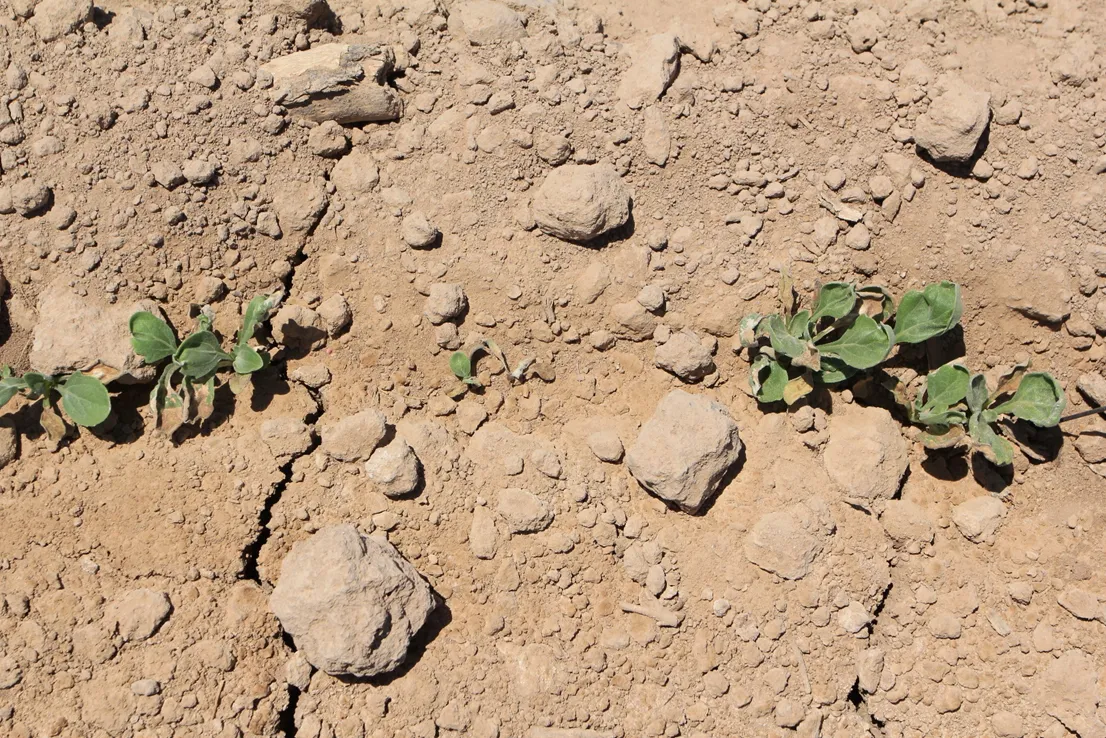
Young guayule plants show damage after Aim application.
Bill McCloskey
For grass weeds, Fusalide DX can be utilized over the top. Perennial grass weeds may require multiple applications. Paraquat is also labeled for broad-spectrum weed control in guayule. Paraquat must be post-directed on alleyways in larger guayule plants and should be sprayed with a hooded sprayer. It is highly recommended that guayule be planted in a field known to have low weed pressure. This will improve the competitive advantage of guayule and improve chances of a dense, healthy guayule planting. After stand establishment and canopy closure, guayule will outcompete weeds and require little to no weed control in the second year of growth.
Insect Control
Mature guayule produces resin that generally repels insects. These keep the plant protected for the majority of its life, except for the cotyledon and fist leaf stages. During this early establishment period, the primary pest is the pale-striped flea beetle. The beetle prefers the cotyledons. They will feed on the young leaves, but the majority of the time, the feeding damage to the first true leaves is insignificant to the overall health of the plant and it will survive.
Seeds are typically treated with NipsIt insecticide for protection of seedlings. The NipsIt treatments may offer limited protection when flea beetle pressure is high and significant stand loss can happen quickly.
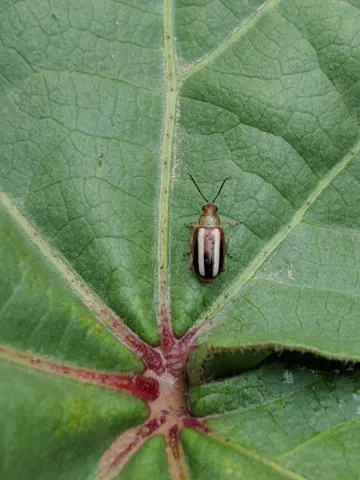
Flea beetle on leaf.
Naomi Pier
Contact your local Cooperative Extension office if you need information on pest identification and control.
Fertilization
Guayule is a low input desert shrub and requires very few inputs for production. Recent SBAR research found that guayule growth responds similarly across a wide range of nitrogen fertilization levels, but too much or too little nitrogen will limit growth. To ensure growth levels remain adequate, fully developed leaves from the end of a six-inch long stem should be analyzed for their total nitrogen concentration. The nitrogen leaf concentration should be between 2.5% and 4.2%. Levels below 2.5% should receive a light to moderate application of nitrogen and levels above 4.2% should refrain from further nitrogen applications until leaf test levels indicate otherwise.
Phosphorus fertilization has not been found to impact guayule growth while potassium studies indicate that guayule yields positively benefit from potassium fertilization, but there are currently no recommended levels for production.
Disease Management
More than 20 pathogens have been reported to attack both aboveground and belowground parts of guayule. The most important pathogens are soilborne organisms including Phytophthora, Pythium, Fusarium, Macrophomina, Rhizoctonia, and Verticillium spp. These soilborne diseases often occur in heavy soil with poor drainage and irrigation management issues.
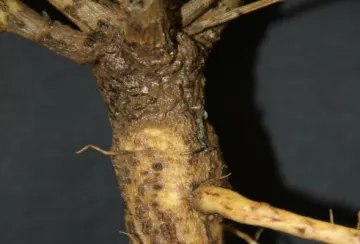
Phytophthora crown rot.
Alex Hu
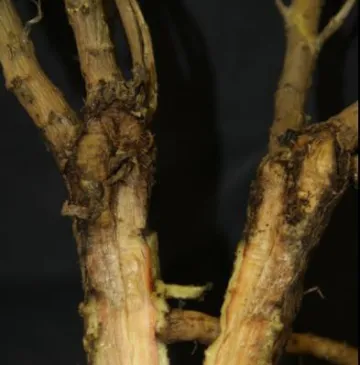
Phytophthora root rot.
Alex Hu
Common symptoms of root rot and vascular wilt diseases include yellowing, wilting, and plant death. Disease incidence is directly related to heavy watering during periods of high temperatures, and they often occur under conditions of high temperatures and in plants with severe drought stress. The best way to control soilborne diseases is to choose planting sites with sand loam soil, and implement good irrigation management to avoid water-logged conditions.
Contact your local Cooperative Extension office if you need information on plant disease identification and control.
Irrigation Strategies for Guayule Grown in the U.S. Desert
Average annual water application rate of approximately 2.4 ft/year optimizes guayule rubber production as a function of water.
Flood, solid-set sprinkler, and gravity drip irrigation methods have been used for germination. Soil surface should be kept wet for about 5-10 days after planting for seedling germination. After germination, guayule seedlings should be kept well-watered by irrigating several times during the next seven weeks using level furrow irrigation.
After germination, flood irrigation can be used at a rate of 4”-5.8” per event. There are two irrigation events per season, during spring, summer and fall of the first year of growth. In the second fall, one of the two irrigations can be skipped. No water is applied during winter due to plant dormancy. The plant can also survive with no irrigation water application for several months.
The WINDS (Water-use, Irrigation, Nitrogen, Drainage, and Salinity) online irrigation app (https://viz.datascience.arizona.edu/WINDS/) includes 40 simulations of guar irrigation and 60 simulations of guayule irrigation from SBAR irrigation experiments. Contact Peter Waller to set up WINDS for guayule irrigation management.
Additional Resources:
Guayule Harvesting Strategies
Guayule is harvested unlike any other crop grown in field production. Since the rubber and resin are stored inside the plant, the entire plant must be removed for processing. Currently, there are two models being tested to maximize processing efficiency. The first and older process uses specialized saws to cut the entire plant 1 to 2 inches above ground level. The shrubs are then left in the field to dry for several days before the material is bailed using 5-foot X 6-foot bales. These are then transported to the processing facility for griding and chemical extraction of rubber and resin.
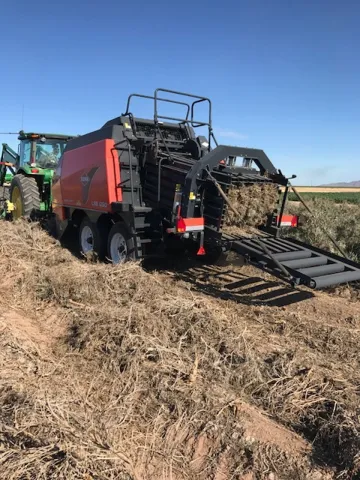
Baling guayule plants in the field.
Bridgestone Americas
The second, newly adopted system involves using a forage harvester to cut and chop the plant material, which is then hauled to the processing facility.
Guayule Processing and Contracts
Processing
Chemical extraction of the rubber and resin from ground up guayule plants occurs in a large processing facility similar to the Bridgestone experimental extraction facility.
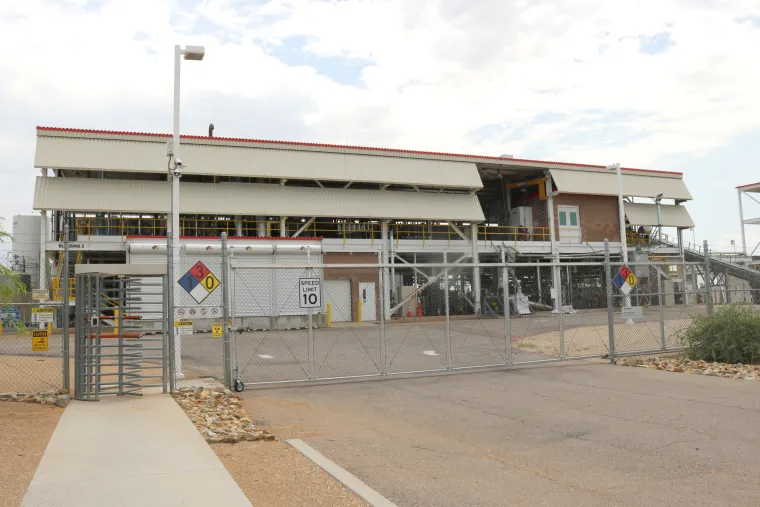
Bridgestone experimental extraction facility in Mesa, Arizona.
Bridgestone Americas
Simultaneous extraction occurs with acetone, hexane, and pentane to extract resin and rubber utilizing what is known as the Bridgestone/Firestone process. This results in raw natural solid rubber and resin. A third coproduct, bagasse, remains after the chemical extraction process is complete. This material is being researched for use as fuel or fiberboard feedstock.
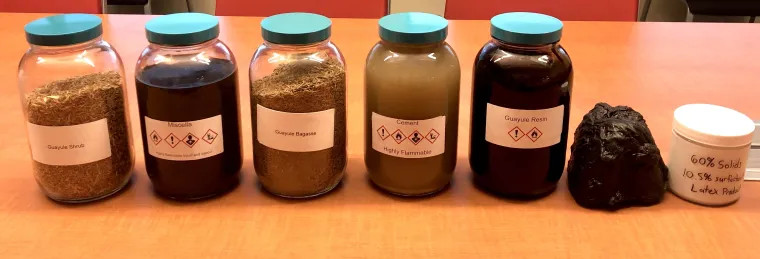
Bridgestone Biorubber Process Research Center guayule processing stages (L-R): raw feedstock, miscella (a solvent mixture), begasse, rubber cement, guayule resin, rubber, and latex.
Jacqueline Bruhn
Contracts for Guayule
As production of guayule is ramping up, all contracts to grow guayule will initially be made through Bridgestone Americas. Currently they are increasing production acres throughout Central Arizona and are looking for additional growers. If you are interested in learning more, contact Bridgestone Americas for contracting details and information associated with growing guayule.
Guayule Economics and Sustainability
Content under development.




